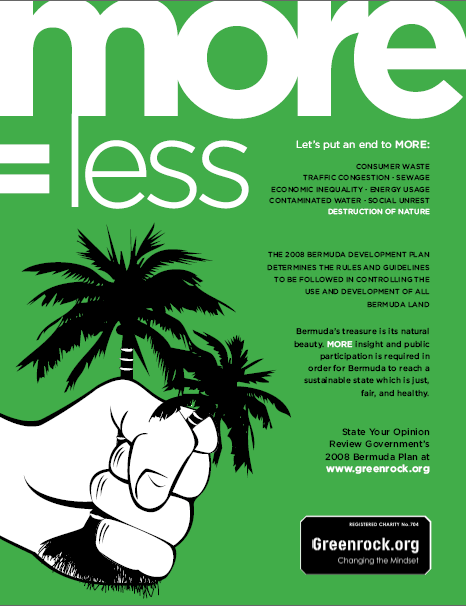In order to understand why it’s important for the general public to review this document, it is important to step back and understand the historical facts and criticisms that have been expressed against the Planning Department about their delays in overhauling the 1992 Plan (which the 2008 will replace). Here is a short list of those facts and criticism (pdf file) 29.97 Kb .
Greenrock is currently reviewing the 2008 Bermuda Plan Draft and will provide our detailed comments to the Bermuda National Trust, as well as posting our comments on the Greenrock website. However, from our initial review, there are a number of emerging themes, including:
-
-
- The Plan lacks guidance or direction on what mechanisms are in place to ensure energy efficient building design.
- The Plan only refers to a planning/conservation strategy as follows: "encouraging energy efficient building design and the development of renewable energy sources".
- The Plan only requires builders to submit an Environmental Impact Statement (EIS) with a planning application based on the discretion of the Development Applications Board (DAB).
- The Plan does not call for an EIS as standard practice for all types of development.
- The Plan refers to ‘large scale’ residential development as 20 or more dwelling units. The concept of ‘large scale’ should be adapted to something more fitting to Bermuda’s size.
- Similarly, the Plan refers to ‘large scale’ sub-divisions of land from 10 or more lots. The Plan should be adapted to something more fitting to Bermuda’s size.
- Within the Designs section, under ‘Energy Efficient Buildings’, there seems to be more subjective discretion of the Board to deny utilization of these technologies if it conflicts or detracts from the traditional features of a building. This seems counter-productive since Bermuda’s traditional architectural design never envisioned installation of micro-renewables.
- Throughout the document, when it comes to water supply, there is no mention of utilizing conservation techniques. Instead, it only refers to access to water via catchment, piped potable, or well access. At the same time, there is no reference to alternative ways to re-use water such as Grey Water Systems.
- When it comes to Tourism, Commercial, Mixed Use, and Industrial developments, there should be clearer guidelines as it relate to energy efficiency, water conservation, and waste disposal.
- From a transportation perspective, there is more emphasis on parking spaces, public transport, and maintaining roadways and sidewalks. There is little about pedal bikes and bike paths. There is no discussion about multi-user or alternative energy vehicles.
- If there is encouragement to create residential development in commercial or mixed use locations to help alleviate traffic congestion to those sites, then the minimum provision table will need to be reviewed since there will be more emphasis on foot traffic and public transport.
-
Greenrock encourages all members of the public to present their opinions to Government in order to ensure that our views are represented in the Plan.
Also, we encourage you to circulate our e-flyers to those in your community. Or print them and post them in public areas. With your help, we can make meaningful change and ensure that Bermuda’s future is just, efficient and healthy.
E-Flyers (click on names above each image)
Energy Usage 69.41 Kb - Traffic Congestion 98.72 Kb - Destroy Nature 100.62 Kb




